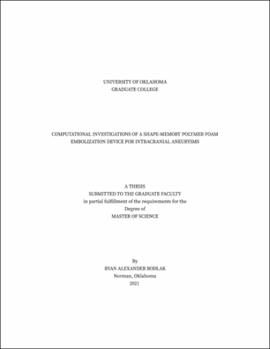| dc.contributor.advisor | Lee, Chung-Hao | |
| dc.contributor.author | Bodlak, Ryan | |
| dc.date.accessioned | 2021-08-04T15:01:37Z | |
| dc.date.available | 2021-08-04T15:01:37Z | |
| dc.date.issued | 2021 | |
| dc.identifier.uri | https://hdl.handle.net/11244/330199 | |
| dc.description.abstract | The objective of this research is to determine the efficacy of an intracranial aneurysm treatment option. An open‐source computational fluid dynamics software is used to simulate blood flow through 6 patient‐specific intracranial aneurysm geometries for 42 different cases. Virtual shape memory polymer foam embolization devices are created and implanted into the geometries. Different porous media parameters are considered for the embolic devices, and it is found that devices with a permeability of ∼5e-9 m2 can reduce aneurysmal inflow by 90% for various geometries of the treated aneurysm and its surrounding parent arterial vessel. For a wide‐necked aneurysm, devices with a permeability of <5e-8 m2 reduce the average flow velocity within the aneurysm space by >60%, indicating that they may be able to provide that level of performance for most aneurysm morphologies. As such, a permeability range of 5e-9–5e-8 m2 is recommended for the device. Furthermore, material removal from the center of the device is found to be feasible for larger aneurysm devices if compressibility is deemed a concern. For a high‐inflow case, the average aneurysmal velocity reduction is within 2% of the uncored device for all cored devices with a material thickness of at least 1.5 mm occluding the inlet area. Convective heat transfer is also modeled to determine the safety of the thermally stimulated shape memory polymer device. Steady‐state simulations identify the worst‐case geometry, a deep aneurysm with little opportunity for convection. Transient heat transfer during the device deployment process for 2 stimulus temperatures is modeled with this aneurysm, demonstrating that the vessel walls can reach the stimulus temperature of 40 °C and 45 °C within seconds and take over a minute to cool back to near body temperature. The threshold for brain tissue damage is not reached, but nonetheless, it is suggested that the temperature and heating time be kept as low as possible. Full model validation is not available, but general verification of the flow fields in untreated aneurysms is achieved by comparing simulation results to those obtained by other research groups in a modeling competition. | en_US |
| dc.language | en_US | en_US |
| dc.rights | Attribution-NonCommercial-NoDerivatives 4.0 International | * |
| dc.rights.uri | https://creativecommons.org/licenses/by-nc-nd/4.0/ | * |
| dc.subject | computational fluid dynamics (CFD) | en_US |
| dc.subject | intracranial aneurysms | en_US |
| dc.subject | shape memory polymer foam | en_US |
| dc.subject | endovascular embolization | en_US |
| dc.subject | medical device design | en_US |
| dc.title | Computational investigations of a shape‐memory polymer foam embolization device for intracranial aneurysms | en_US |
| dc.contributor.committeeMember | Chang, Kuang‐Hua | |
| dc.contributor.committeeMember | Dai, Chenkai | |
| dc.date.manuscript | 2021-07 | |
| dc.thesis.degree | Master of Science | en_US |
| ou.group | Gallogly College of Engineering::School of Aerospace and Mechanical Engineering | en_US |

